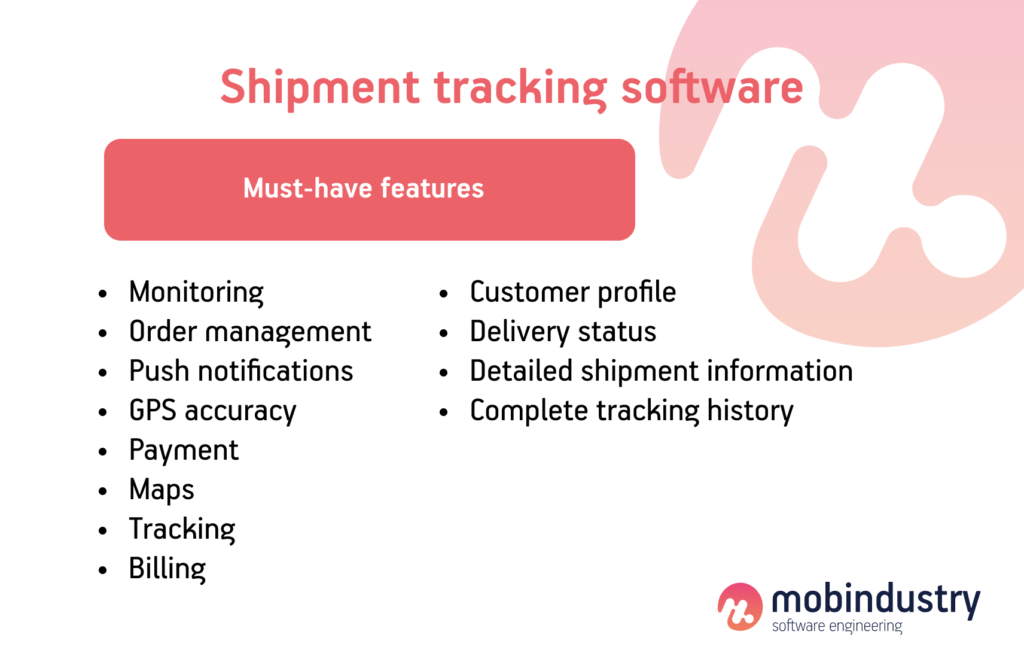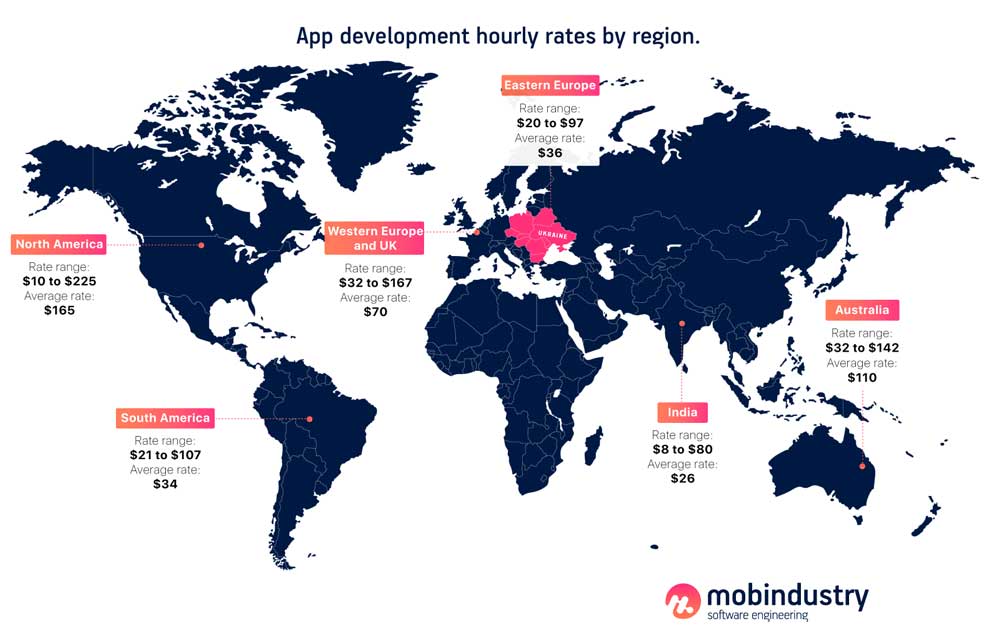How to Build Shipment Tracking Software for Your Business
In this article, we provide you with an ultimate guide on how to create shipment tracking software and also give you a list of the most successful shipment tracking products.
Most businesses require some sort of order tracking system. Customers expect to be able to track their orders in real-time right after purchase. This has become standard practice for nearly every major online store. But the idea of order tracking is starting to amaze every business. Companies trading in any physical product can see the benefits of order tracking.
What is shipment tracking software?
Shipment tracking software is software designed for e-commerce and trucking businesses to keep their customers updated on the status and location of their orders.
This type of software collects data generated by multiple telecom operators and automatically sends real-time updates to users and their clients. The software displays information about the shipment and destination, as well as the delivery schedule, estimated arrival date, delivery method, and tracking number. Customer information is automatically updated when the delivery status changes.
How does shipment tracking software work?
The tracking program is straightforward and provides your customers with complete shipping information. The process includes:
1. In a shipping document, shipment tracking is first created.
2. After the order is packed and shipped, the tracking number will provide all relevant parties with tracking information.
3. Notifications are sent to your customers, customer service representatives, and sales representatives based on various events. Notifications may include:
- When the package is received
- When cargo is in transit
- When the package is delivered
4. Once your package has been delivered, you will be presented with delivery confirmation. The data can then be permanently stored in your company’s database.
When does your business need shipment tracking software?
Many business owners are looking for help in meeting customer renewal requests. Especially for companies whose production process takes a long time. Repeatedly answering calls and emails from customers can be time-consuming, distracting, and frustrating. A custom order tracking system can be very helpful when your business is faced with scenarios like this.
Long manufacturing times
Production cycles, which can last for weeks or months, are often a concern for customers. Companies with long lead times often receive repeated update requests from their customers.
These long lead times and delays are becoming more frequent as supply chain issues continue to impact every industry. An order tracking system helps manufacturers with extended lead times keep their customers in the loop as their orders go through every step of the process.
Frequent requests for updates from customers
Clients want to know where their products are located. Some customers want to know more than others. This creates unnecessary stress and strain on maintenance staff. An online order tracking system solves this issue very quickly.
Customers can be directed to search your website for an order or receive email notifications tied to your own order tracking system. This will allow your team to get more work done instead of answering the same emails and phone calls over and over again.
Must-have features for shipment tracking software

If your business involves any mode of transportation, the tracking app can help you optimize and build your business, and increase your ROI. Adding a tracker to your courier tracking app or driver app will result in more relevant interaction for your users and increase your business’s competitiveness.
Monitoring
An on-demand delivery tracking app has a monitoring function to display information such as package status, location, route calculation, and real-time navigation.
Payment
An online payment system for any product or service received by customers, which can be utilized in tracking and shipping applications with various payment methods.
Maps
The tracking and delivery app built for businesses on demand supports Google Maps, and hybrid open street maps, integrating them into your app with geolocation added.
Order management

A delivery tracking app should make it easy to manage all your orders from one platform. Get complete control and insight into all of your orders at every step of the shipping process from all your sales channels.
Save time by automatically applying actions to orders based on the criteria you define. Synchronize as many orders as you want from any number of sources you use by connecting a sales channel, manually creating orders, uploading CSVs, or entering data via API.
GPS accuracy
This setting indicates GPS accuracy and also tries to determine if the phone has a GPS function.
Push notifications
Every action taken in the shipping tracking app is updated to alert the user of all situations.
Tracking

Provides users with an amazing platform for the real-time exchange of shipment data between distributors, carriers, and customers. GPS tracking or IoT-based tracking options can help dispatchers and customers supervise the cargo delivery process 24/7 on their mobile phones and web applications.
Billing
Automates the processes of creating and sending invoices, adding attachments and notes, and setting up invoices for users.
Customer profile
Each customer should have a personal profile that includes their address, personal information, orders, and payments. Onboarding should include registration through email and the collection of personal data.
Delivery status
Confirmation of delivery status from customers by electronic signature or scanning a QR code generated by the client application.
Detailed shipment information
Include addresses, carrier information, and delivery service.
Complete tracking history
Detailed location, time, and status information that you can refer to in case of a problem.
Four steps to develop a shipment tracking software
Here are the four steps to make your shipment tracking software idea come to life and simplify the development process.

1. Choose business requisites and goals
You need to analyze the specifics, capabilities, and requirements of your business in order to create a tracking application as efficiently as possible. For example, study the geography of the delivery service. Is it within the city limits or will it expand in the future? Be aware of the restrictions on package weight and size. Both small and large cabinets, etc. can be supplied.
2. Research your app’s target market
When developing shipment tracking software, the first thing you need to consider is the target audience. Understanding your users’ needs makes development easier and leads to a better final product. Find out as much as you can about your potential users. You can start by researching the following:
- Demographics. Find out the average age of your users, where they live, what devices they use, etc.
- Behavioral trends. Find out what decreases a user’s desire to use your software, your users’ security expectations, and so on.
To develop amazing shipment tracking software, we suggest creating a user persona, or a detailed portrait of your ideal user.
3. Hire an app development team
The third step is to find a development team you want to work with. The first phase of development will include business analysis, developing a technical specification, estimating the development cost, and planning the project. Before diving into the actual development of your shipment tracking software, you and your team should set up an app development workflow, choose the main features for the app, and design the app concept.
Then your development team should create project milestones and start working on the minimum viable product, or MVP.
4. Create an MVP
Creating shipment tracking software is a big and complex project. We recommend launching a minimum viable product first and testing its technical and business performance. By using an MVP approach, you’ll be able to find out what users like and don’t like in your app. Then you’ll be able to consider their feedback and improve your shipment tracking software.
Examples of best shipment tracking software

ShipStation Software
ShipStation is a multi-carrier solution designed to speed up the shipping process for online stores. Features like bulk delivery, shipping discounts, inventory, customer management, and custom branding all help to streamline order fulfillment.
Users can import orders from more than 60 sales channels and let ShipStation automatically apply customizable presets and shipping options. Once you create shipping labels or send orders to an order fulfillment company such as FBA or ShipWire, ShipStation broadcasts delivery statuses and tracking information for each sales channel.

Managing customer communications can be time-consuming, ShipStation simplifies this process by offering custom packing lists, emails, and tracking page templates to provide customers with a unique, branded experience. Other features include detailed reporting, pre-filled international customs forms, the ability to combine and split orders, and extended user rights and limitations.
Shippo
Ecommerce is complex. Shipping doesn’t have to be. Shippo connects you with the best rates at carriers using a solution integrated with your business and will provide you with experienced support at every stage so you can grow into the future.

Manage shipping for all of your sales channels and get access to exclusive discounts from USPS, UPS, FedEx, DHL + 80 more, automated workflows, detailed tracking and notifications, seamless returns, international customs declarations, and more.
Freightview
If you ship LTL freight or parcel, you can use Freightview to pull all of your negotiated LTL and parcel rates into one place so it’s easy to compare your options and pick the best one. Then you can schedule pickups, prepare bills of lading, print shipping labels, and track your shipments from pickup to delivery.
Its universal address book means you never have to enter an address twice. In addition, you can visualize all delivery data in the form of charts, graphs, reports, and tables for download.
Orderhive
Orderhive is a cloud-based order management system designed for small, medium and large retail, wholesale, and distribution businesses.
With Orderhive, retailers can track their orders, stocks, and shipments across all online sales channels, as well as analyze team performance by function and locate stock. The system also provides users with real-time updated information about their business through reporting and analytics features.
In addition, Orderhive allows users to store customer information for future use in marketing, create purchase orders, track inventory in warehouses, complete dropshipping and 3PL orders, track the raw materials required for products, create invoices, and track payments.
Kuebix TMS
Kuebix, a Trimble company, is a cloud-based transportation management system (TMS) for both inbound and outbound logistics shippers and carriers. The solution serves a variety of carriers and modes of transport, including less laden (LTL), parcels, less containerized (LCL), intermodal, and heavy air freight.
Kuebix TMS offers an integrated platform for assessing, booking, and tracking shipments. Shippers can set multiple shipping rates, negotiate LTL and parcel rates with their carrier, or get rates for special deliveries. Users can access Kuebix on their mobile devices to remotely create, book, and manage shipments.
Kuebix offers a range of add-ons that can be used internationally, as well as integrations with third-party business applications such as Quickbooks, Infor, and Oracle NetSuite that enhance the capabilities of its supply chain.
LogiNext Mile
LogiNext Mile is a cloud-based transportation management solution that allows users to plan delivery routes and track vehicles. The solution is suitable for industries like manufacturing, pharmaceuticals, retail, banking, and insurance.
The dashboard displays trip planning information that includes trip number, location history, delivery driver names, and other related information. It also provides a map interface to track driver activity and location, and communicate with drivers via push notifications.
Users can analyze delivery networks using trendlines and heatmaps.
The solution provides visualization tools to help users compare planned routes with actual routes.
SendCloud
Sendcloud is a shipping platform that helps e-commerce businesses streamline shipping tracking, checkout, and order management. A centralized dashboard allows employees to print labels for bulk shipments, define custom rules to automate delivery method assignments, and create custom workflows in real-time.
The platform allows users to automatically create CN22 forms with shipping labels for customs clearance, and print kits and packing slips in real-time. Professionals can use the app to send e-mails to customers with estimated delivery times and pick-up points. Plus, it allows admins to personalize the shipping tracking page with their own logo, colors, and banner ads.
How much does it cost to build shipment tracking software?
The cost of developing a shipment tracking software depends on these factors:
- Product features
- Product design
- Hourly rate of your development team
- Project size and complexity
- Technology stack
- Number of team members on the project
- Time frame
The biggest factor that influences a project’s cost is the hourly rate of developers, and that often depends on their location. For example, an application that costs $40,000 to build in the US will cost around $9,000 if developed by engineers in Ukraine.

Developing your project with a company based in Eastern Europe is cost-effective and gives you access to top talent.
Final thoughts
A shipment tracking software, if developed correctly, can become successful and add value to your business.
Key takeaways:
- Customers expect to be able to track their orders in real-time right after purchase.
- Shipment tracking software is software designed for e-commerce and trucking businesses to keep their customers updated on the status and location of their orders.
- A custom order tracking system can be very helpful when your business is faced with scenarios such as long manufacturing times and frequent requests for updates from customers
- You need to analyze the specifics, capabilities, and requirements of your business in order to create a tracking application as efficiently as possible
- When developing shipment tracking software, the first thing you need to consider is the target audience. Understanding your users’ needs makes development easier and leads to a better final product.
- Find a development team you want to work with. The first phase of development will include business analysis, developing a technical specification, estimating the development cost, and planning the project.
- We recommend launching a minimum viable product first and testing its technical and business performance.
- Developing shipment tracking software with a company based in Eastern Europe is cost-effective and gives you access to top talent.
If you want to create shipment tracking software but don’t know where to start, contact Mobindustry for a free consultation.
Frequently Asked Questions
- In a shipping document, a shipment tracking is first created.
- After the order is packed and shipped, the tracking number will provide all relevant parties with tracking information.
- Notifications are sent to your customers, customer service representatives and sales representatives based on various events.
- Once your package has been delivered, you will be presented with a delivery confirmation. The data can then be permanently stored in your company's database.

